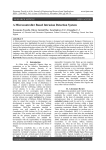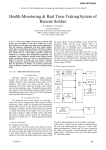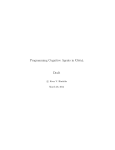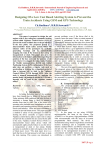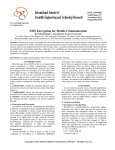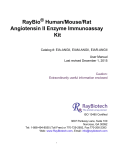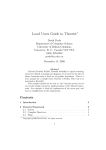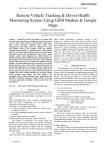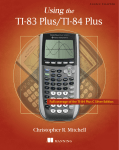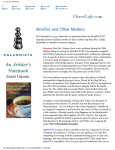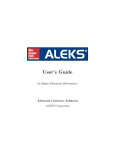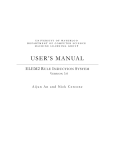Download Word Problem Solver for Probability
Transcript
Dr. Abhijit R. Joshi et al Int. Journal of Engineering Research and Applications
ISSN : 2248-9622, Vol. 4, Issue 7( Version 5), July 2014, pp.76-81
RESEARCH ARTICLE
www.ijera.com
OPEN ACCESS
Word Problem Solver for Probability
Priyanka Dalvi1, Sanjana Oulkar2, Siraj Cotecha3, Dr. Abhijit R. Joshi4, Prof.
Harshaldalvi5
1
(B.E. Student, Department of I.T., DJSCOE, University of Mumbai, Mumbai, India)
(B.E. Student, Department of I.T., DJSCOE, University of Mumbai, Mumbai, India)
3
(B.E. Student, Department of I.T., DJSCOE, University of Mumbai, Mumbai, India)
4
(Vice Principal (academic), Head of Department-IT, DJSCOE, University of Mumbai, Mumbai, India)
5
(Assistant Professor, Department of I.T., DJSCOE, University of Mumbai, Mumbai, India)
2
ABSTRACT
Word Problems are designed to help students to learn the application of mathematical concepts, algebraic
identities and formulae in the real world. Variables are assigned the values of „real-world‟ entities and a logical
approach in solving them is established. They help the students to bridge the gap between theoretical knowledge
and the real world application of it by giving them hypothetical situations about the same. Probability is a
measure or estimation of how likely it is that a particular event will happen. Probability concepts need to be
properly understood before attempting to solve any problem related to it. In view of this a survey was
conducted. Students from various schools and coaching classes were approached for the same. The study shows
that majority of the students experience difficulties in identifying and understanding what exactly the word
problem signifies and what approach it demands. Also, the process of learning Probability needs to be
specialized given the different understanding levels of each and every student in contrast to the generalized
education techniques that are being used in traditional classrooms. Keeping in mind these issues, Word Problem
Solver for Probability is implemented, which caters to the learning needs of each and every student individually
by providing a step-by-step solution to all problems from the Probability domain.
Keywords - Events, Probability, Problem Solver, Sample Space, Teaching Aid Word.
Approach that is followed to develop the system.
Section 4 discusses Results obtained along with
I. INTRODUCTION
Probability is one of the most important topics of
Mathematics. It encompasses a variety of problem
sample outputs. The paper ends with conclusion and
types and their variations. It is observed that despite
the future scope.
knowing the formulae and calculations, students
cannot solve probability word problems correctly.
Reasons for this can be traced to lack of basic
II. LITERATURE SURVEY
understanding of the concepts and a correct approach
Probability provides a quantitative description of
to look at them. Once these basics are understood,
the likely occurrence of a particular event.
students will be able to tackle any problem without
Probability is conventionally expressed on a scale
difficulty. Word Problem Solver for Probability will
from 0 to 1; a rare event has a probability close to 0,
help students in this area. It will guide them about
a very common event has a probability close to 1, [4].
Probability, help them understand the questions and
Probability is used widely in areas of study such as
provide them with an accurate step-by-step solution.
mathematics, statistics, finance, gambling, science,
Also, students can use it for verifying their answers
artificial intelligence, machine learning and
and identifying mistakes, if any, in their solutions.
philosophy too. Word problems related to Probability
Word Problem Solver for Probability will allow for a
are of three types [3]. They are:
personalized way of teaching taking into account
1. Specific events are described and probability is
every single student. In order to enhance the
asked.
traditional monotonous approach of classroom
2. A set of variables is given. The probability of
teaching, Word Problem Solver for Probability is
specific
combinations
and
permutations
developed. It not only serves as a learning tool for
(arrangements) is expected.
students but also as a teaching aid for the teachers.
3. The probability of certain events is given and
The rest of the paper is organized as - Section 2,
conditional probability is expected.
covers the literature survey giving overview of the
Various methods are implemented for teaching
existing systems used for teaching concepts of
Probability currently. Majorly the existing methods
probability. Section 3 talks about the Proposed
are confined to classroom teaching and to some
www.ijera.com
76 | P a g e
Dr. Abhijit R. Joshi et al Int. Journal of Engineering Research and Applications
ISSN : 2248-9622, Vol. 4, Issue 7( Version 5), July 2014, pp.76-81
extent students refer to material available online for
the same. The approach of these is however, mainly
syllabus centric and does not focus on overall
understanding of the topic and development of
student.
But, learning is defined to be a goal-directed act.
The involvement of the student in learning is as
important and fundamental as the teacher. Correct
knowledge can be passed on in a correct manner only
with the mutual coordination and cooperation of
both; the teacher and student.
In this section it is intended to find out the
reasons and coin conclusions about why a simple
topic like Probability is considered to be tough to
understand and grasp by the students. In doing so, all
the existing systems involved in this area are
evaluated.
2.1. TRADITIONAL APPROACH
The traditional method involves classroom
teaching, normally associated as the chalk and board
method, where teachers teach the students manually.
The general method observed is explaining the
concepts first followed by making the students solve
a few examples in class and the remaining as
homework.
In a classroom of minimum 35-40 students, it is
difficult to ensure each and every student has
understood the concept properly. Even a small doubt
in understanding concepts of a critical topic like
Probability can create various difficulties for the
students in solving further problems. Moreover,
students cannot always find the appropriate guidance
when they get stuck in solving and practicing the
exercises on their own. Thus, the absence of a teacher
at that point of time proves to be a major hindrance.
2.2. ONLINE VIDEOS
„Learning Probability‟ videos available online
have been successful in imparting distant education
to students across the globe. They are easy to access
and students can select a particular sub-topic they
want to watch and follow the same. As of today,
these videos receiving as many as 5,83,772 views
clearly speaks out for their popularity and excellence
in reaching out efficiently to students.
However, with a lot of content available online,
it is difficult for a student to identify and choose for
himself/herself what is apt and correct. Also, the
learning pace requirements of each student are
different at different levels. Precisely stating, school
students need a step by step approach towards the
final answer because every correct step and formula
used carries marks which also surfaced in the survey.
On the other hand, college students who want to
excel in competitive examinations need a quick
understanding of the problem and arrive to the
answer in a stipulated amount of time. Online videos
www.ijera.com
www.ijera.com
fail to address these needs. Language barrier is also a
major problem.
2.3. MATHWAY
Mathway is a free tutor online service which
resolves users‟ mathematics problems based on
users‟ stated problem. It is a web application.
Mathway provides features like Basic Maths, PreAlgebra, Algebra, Trigonometry, Precalculus, and
Calculus to specify the category of the problem [5].
Choosing the category provides a set of commonly
used symbols for those types of problems and makes
solving them easier. However, systems like Mathway
have a few drawbacks. They are:
1. Web applications like Mathway absolutely
require compatible web browsers. If a browser
vendor decides not to implement a certain
feature, or abandons a particular platform or
operating system version, this may affect a huge
number of users.
2. User Interface is not interactive.
3. Mathway cannot be used to solve word
problems.
4. A basic understanding of Probability is needed in
order to use Mathway efficiently.
5. Applications like Mathway depend entirely on
the availability of the server delivering the
application. At times server is too busy to solve
submitted problems.
To overcome these problems in existing system
and also to address the learning requirement of
students in online scenario, Word Problem Solver for
Probability is developed.
III. THE PROPOSED APPROACH
The system is implemented using the principles
of Artificial Intelligence because it has the ability to
create never-ending thought process that can be used
to solve problems.
3.1. APPROACH TO BUILD THE SYSTEM
The proposed system accepts a problem inputted
by the user and aims to solve it. For doing this, it
should have the knowledge of the events and
conditions mentioned in the problem. It needs to
generate sample space and select the sample points
that satisfy the mentioned condition in the problem
and generate a solution. The knowledge for doing all
this can be acquired from previously solved
problems. Thus, it requires knowledge restoring from
sample spaces stored and probability problems solved
and referring to it later. For doing all this, the system
will require some internal memory. This internal
memory stores the percept history, which is the
salient feature of model-based reflex agent [1].
Looking at the approach to build the system, now, let
us see the framework of the system.
77 | P a g e
Dr. Abhijit R. Joshi et al Int. Journal of Engineering Research and Applications
ISSN : 2248-9622, Vol. 4, Issue 7( Version 5), July 2014, pp.76-81
3.2
FRAMEWORK
OF
PROPOSED
SYSTEM
The system uses object oriented architecture
style because an object oriented design views the
system as a series of cooperating objects and these
objects are discrete and independent. They
communicate through interfaces by calling methods
and hence provide for reusability, testability,
extensibility and make the system highly
understandable.
The architecture of the system comprises of five
major modules. Figure 1 illustrates the architecture of
the system. The interactions of the various modules
and their dependence on each other are shown in
Figure 1. Now, let us see the role played by each
module of the system.
www.ijera.com
describe one event, the problem is identified to be of
the first type by the module.
Consider an example: Two die are thrown. What
is the probability that the number on first dice is
greater than the number on the second dice? [3].
For the above example, this module analyses the
problem and identifies it to be of the “first type”.
3.2.2 Event Identifier
After determining the problem type, the next task
is to identify the event for which probability is to be
determined and it is accomplished by Event Identifier
module. For this, Event Identifier module analyses
only a specific part of the problem statement. This
specific part is that part of the word problem which
follows the keywords like “probability”, “chances”,
“odds”. For the given example, the event is: “that the
number on first dice is greater than the number on the
second dice”. The event thus identified is then passed
to the next module which is the Sample Points
Generator.
3.2.3 Sample Space Generator:
After identifying the problem type, the sample
space for the mentioned problem will be generated.
The module, i.e., Sample Space Generator will
generate the sample spaces for problems of Type 1
and Type 2.The probability of any event is given by:
P(Event A) =
Fig. 1: Architecture of Proposed System
3.2.1 Problem Type Identifier:
As mentioned previously, word problems related
to probability are of three types:
1. Specific events are described and probability is
asked.
2. A set of variables is given. The probability of
specific
combinations
and
permutations
(arrangements) is expected.
3. The probability of certain events is given and
conditional probability is expected.
Thus before solving any word problem on
probability, it is necessary to identify the type to
which the problem belongs. The question entered by
the user will be analyzed by the Problem Type
Identifier Module. This module parses the word
problem to identify specific keywords which would
determine the type of the problem [2]. Keywords like
“combination”, “arrangement”, “chosen”, “selected”
would indicate that the word problem is of the second
type. Similarly if problem contains description of
more than one event or if it contains words like
“without replacement”, ”kept aside” then the module
identifies the problem to be of the third type. If
problems do not contain above keywords and only
www.ijera.com
n(Sample Space of Event A )
(1)
n(Sample Space of Universal Set )
Therefore for finding the solution to the problem,
first the sample space is calculated. Since the given
example is of first type, hence, the sample space
generator will generate the sample space which is as
follows:
{
(1,1), (1,2), (1,3), (1,4), (1,5) ,(1,6)
(2,1) ,(2,2) ,(2,3) ,(2,4) ,(2,5) ,(2,6)
(3,1) ,(3,2) ,(3,3) ,(3,4) ,(3,5) ,(3,6)
(4,1) ,(4,2) ,(4,3) ,(4,4) ,(4,5) ,(4,6)
(5,1) ,(5,2) ,(5,3) ,(5,4) ,(5,5), (5,6)
(6,1) ,(6,2) ,(6,3) ,(6,4) ,(6,5) ,(6,6)
}
The number of sample points (for this example,
36) is passed to the module, Probability Generator.
Since, the given example is the “first type”
probability problem; so, the module will contain the
sample sets of common events.
78 | P a g e
Dr. Abhijit R. Joshi et al Int. Journal of Engineering Research and Applications
ISSN : 2248-9622, Vol. 4, Issue 7( Version 5), July 2014, pp.76-81
3.2.4 Sample Points Generator
This module takes as input the event identified
by the Event Identifier module. This module will
identify all the sample points, in the sample space
generated by the second module, that satisfy the
required condition. First step in identifying the
sample points is to scan the event statement for
keywords like „even‟, „odd‟, „less than‟, „greater
than‟, „together‟, „exactly‟, „atmost‟, „at least‟,
„prime‟, „perfect square‟. After this, all the points in
the sample space are tested for the condition
specified by the keyword. If a set of points satisfy the
condition, they are included in the sample points. For
the given example, the event is getting a larger
number on the first dice when two die are thrown.
{
(2,1)
(3,1) ,(3,2)
(4,1) ,(4,2) ,(4,3)
(5,1) ,(5,2) ,(5,3) ,(5,4)
(6,1) ,(6,2) ,(6,3) ,(6,4) ,(6,5)
}
The number of sample points (for this example,
15) is passed to the next module, i.e., Probability
Generator.
3.2.5 Probability Generator:
After identifying the events and the sample
points, now it is possible to calculate the required
probability. The module Probability Generator takes
the inputs from the „Sample Space Generator‟ and the
„Sample Points Generator‟ modules and using the
formula given below it calculates the probability of
the given example.
n(Sample Space of Event A)
P (Event A) =
n(Sample Space of Universal Set)
= 15⁄36
(2)
In this way the probability problem is solved by
generating a step-by-step solution.
IV. EVALUATION AND RESULTS
In this section we start with the walkthrough of
the system as a user. The section ends with an
evaluation study conducted to test the claim that the
Word Problem Solver is a better system.
4.1 Working with the System
The system interface consists of two
distinguished text areas and two command buttons.
Figure 2 represents the initial screen which appears to
the user. The text area named, “Enter the word
problem” is reserved for the user to enter the
question. The user can either type the question in the
textbox or directly paste the question in that space.
www.ijera.com
www.ijera.com
The two command buttons, namely, Solve and Clear
are also provided on the Graphical User Interface.
Fig. 2: User Screen
The user is expected to click “Solve” button after
the question is entered. The solution will be
generated in the Solution area only after “Solve”
button is clicked.
“Clear” button is used to clear the screen if
the user has entered the problem incorrectly. Also,
this button can be used to enter a new problem once
the student has understood the solution to the current
problem.
Let us now analyze how the system works after
the problem is entered. The problem can belong to
any one of the three types that are mentioned in
earlier sections.
A typical dialogue between the user and Word
Problem Solver is shown in Figure 3 where user
enters the problem - “3 Physics and 4 Chemistry
books are to be arranged on a shelf. Find the
probability that no 2 physics books are arranged
together”.
To generate the solution of this question, first,
The Problem Type Identifier module will identify the
key word “arranged” in the question and mark this
problem to be of “Type 2”. Now, it is necessary to
identify the event for which probability is asked. The
Event Identifier Module will analyze the entered
problem. For the question entered, the event is “that
no 2 physics books are arranged together”. Because
the entered problem is identified to be of “Type 2” by
the Problem Type Identifier, the Sample Space
Generator module will generate the sample space for
the problem. For the given problem, there are 7
elements in all (3 Physics and 4 Chemistry). The
sample space will be generated by using permutation
as the question is pertaining to „arrangement‟. Hence,
the sample space is 5040 (7! = 5040). The Sample
Point Generator module will then identify all the
sample points that satisfy the event identified by the
Event Identifier module. For the given problem, since
no two physics books can be arranged together, the
Chemistry books can be arranged in 4P4 ways. The
solution area displays the possible arrangement of
books. Also, the remaining 3 Physics books can be
arranged in 5P3 ways. Hence, the sample points will
be generated by taking a multiplication of the two
arrangements (Physics and Chemistry) by using the
79 | P a g e
Dr. Abhijit R. Joshi et al Int. Journal of Engineering Research and Applications
ISSN : 2248-9622, Vol. 4, Issue 7( Version 5), July 2014, pp.76-81
fundamental theory of multiplication. Thus, the
sample points generated is 1440 (4P4 *5P3). The
Probability Generator Module will take the above
calculated values and generate the probability by
using the formula:
(Sample Space of Event )
1440
P Event =
=
(3)
(Sample Space of Univeral Set )
5040
The individual calculations of each module are
displayed in the solution area thus providing the user
with a step wise detailed solution. In this way, the
student can understand how to solve the probability
problems.
www.ijera.com
Generator Module will generate the probability by
using the Conditional Probability formula:
𝑃(𝐴 ∩ 𝐵) = 𝑃(𝐴) ∗ 𝑃(𝐵/𝐴)
(4)
For a problem involving conditional probability,
the first step involved in finding the probability of the
dice event are displayed. Then the calculations
needed to find the probability of the 3 coins event are
shown and the calculation of the final probability is
presented. Thus, the student gets better understanding
of the word problems from the probability domain.
Fig. 4: Solving of Problem Type 3
Fig. 3: Solving of Problem Type 2
Consider Case 2 as shown in Figure 4 where user
enters the problem “1 dice is thrown and 3 coins are
tossed. Find the probability of atmost 1 tail when you
get an even number”
To generate the solution of this question, first,
The Problem Type Identifier module will parse the
word problem to identify the specific keywords. In
this case, the problem consists of two keywords,
namely, dice and coins. So, it recognizes that the
question consists of more than one event and
identifies this problem to be of “Type 3”. After the
type of problem is identified, the Event Identifier
Module will analyze the entered problem. For the
question entered, the event is “atmost 1 tail when you
get an even number”. Because the entered problem is
identified to be of “Type 3” by the Problem Type
Identifier, the Sample Space Generator module will
generate the sample space for the problem. For the
given problem, there are two different events and
hence two different sample spaces are generated. The
first event is 1 dice is thrown. The sample space for
this event is {1, 2, 3, 4,5,6}. The second event is 3
coins are tossed. The sample space for this event is
{HHH, HHT, HTH, HTT, THH, THT, TTH,TTT}.
The Sample Point Generator module will identify all
the sample points that satisfy the event identified by
the Event Identifier module. For the given problem,
the event of having atmost one tail is given by P(A) =
{HHH, HHT, HTH, THH} and the event of getting
an even number is P(B) = {2, 4, 6} The Probability
www.ijera.com
4.2 Experimental Result and Analysis
A study was conducted so as to understand how
the system benefits the users. And thus, a number of
students were asked for hands on of the system and
their feedback was recorded. Table 1 gives a detailed
description of the parameters considered and their
evaluation.
Table 1: Test Cases and Results
Sr. Evaluation Evaluation
Evaluation
No. Parameter Method
Result
1
System
Students were Students
Approach allowed to use found the stepthe system to by-step
solve
solutions very
problems
useful
2
System
Usability
Students
Design
testing
was found
the
performed
application
with the help easy-to-use
of
few and
students
convenient
3
Syllabus
Students were System
Extent
asked to solve correctly
various
solved all the
problems from problems
syllabus
To test the claim that Word Problem Solver for
Probability is enhanced as compared to all the
existing systems to learn, understand and practice
Probability, a detailed study was conducted. Students
from various board schools were approached. These
80 | P a g e
Dr. Abhijit R. Joshi et al Int. Journal of Engineering Research and Applications
ISSN : 2248-9622, Vol. 4, Issue 7( Version 5), July 2014, pp.76-81
students were asked to attend Probability lectures
held by teachers in classrooms. Then, the students
were allowed to use Mathway to further practice and
learn Probability. The same students were also
introduced to Word Problem Solver for Probability.
They were provided with the user manual of Word
Problem Solver for Probability and allowed to use the
system. The review and feedback of 75 students was
recorded to compare the three approaches, i.e.,
classroom learning, Mathway and Word Problem
Solver for Probability. As shown in Figure 5, the
parameters used for the comparative analysis of the
three systems are Ease of Use, Level of detail in
Solution, Interactivity, and Syllabus Coverage. These
parameters are the basic necessity of any teaching
learning program and the success of a system in
delivering correct knowledge depends on all of these.
www.ijera.com
the students can read aloud their question to the
system instead of typing them in the input field. This
will not only save the time of the students spent in
typing long and elaborate problems but also add an
interactive element to the learning process. Also,
using an optical reader that can convert the question
from an image into readable text can be integrated
with the system. This will enable the students to click
a picture of the question by a cell phone camera and
use the same to obtain the detailed solution. The
system can be extended to cover a large number of
topics in Mathematics where students face
difficulties. Systems like „Word Problem Solver for
Probability‟ can revolutionize the way mathematics is
taught and learnt.
REFERENCES
[1]
[2]
[3]
[4]
[5]
Stuart Russell, Peter Norvig, Artificial
Intelligence - A Modern Approach, Second
Edition, Pearson Publication, 2013.
Wanintorn Supap, Kanlaya Naruedomkul,
Nick Cercone, Steps Towards Accurate
Word Problem Translation, IEEE, 2009.
Algebra
Standard
Ninth
Textbook,
Maharashtra State BoarFd of Secondary
and Higher Secondary Education, 2012.
Statistics
Glossary
Probability,
“http://www.stats.gla.ac.uk/steps/glossary/pr
obability.html”, last accessed on 24-042014.
Mathway, “http://www.mathway.com”, last
accessed on 15-10-2013.
Fig. 5: Comparative Study
From the above analysis, it is evident that Word
Problem Solver for Probability works more
efficiently and is a better teaching learning model as
compared to the existing systems.
V. CONCLUSION AND FUTURE
SCOPE
By giving a step-by-step solution to various
types of problems of Probability, Word Problem
Solver for Probability can now serve as a powerful
tool to help students to learn probability and the
underlying concepts. Student can use it as a tool to
solve his/her own doubts. By using Word Problem
Solver student can identify the exact mistakes
committed by him/her. The elaborate explanation of
numerical can help the student to understand the
mistake made by him/her and how to avoid it in
future. Student can use the system repeatedly to solve
the probability problem to master the concepts.
Teacher can use it as teaching aid in classrooms for
interactive teaching learning process.
The system can be enhanced further by
incorporating audio features with the help of which
www.ijera.com
81 | P a g e








